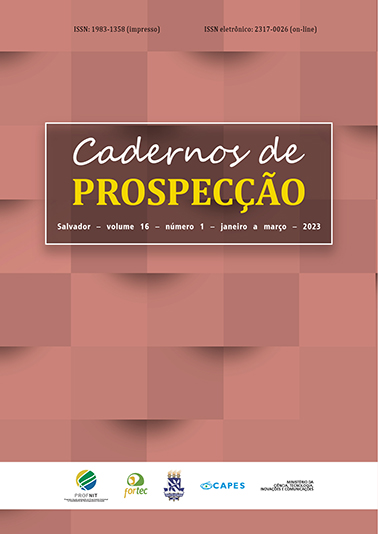Prospective Study on the Application of Bioremediation to Aquaculture
DOI:
https://doi.org/10.9771/cp.v16i1.49089Keywords:
Aquaculture, Bioremediation, Prospection.Abstract
Aquaculture has emerged as an alternative for food security worldwide, while bioremediation has been a suitable technology to mitigate the environmental impact of effluents. This study aimed to carry out bibliographic and patent surveys on bioremediation and aquaculture in different scientific bases, such as Scielo and Capes, in addition to the technological bases of INPI and Orbit Intelligence. Further, we sought to explore the contributions that bioremediation can offer to aquaculture. It was observed that the extent of technological production is below the scientific literature on this topic, and the treatment of aquaculture effluents is still incipient. China and the USA are the main countries in the development of these studies and technologies. Moreover, there is a significant number of expired patents in the public domain, which can be applied in the Brazilian context, that is a thriving environment to aquaculture and faces challenges regarding environmental and food security issues.
Downloads
References
ANA – AGÊNCIA NACIONAL DE ÁGUAS. Panorama das águas: Quantidade de água. [2020]. Disponível em https://www.ana.gov.br/panorama-das-aguas/quantidade-da-agua. Acesso em: 26 jun. 2020.
BRITO, L. O. et al. Bioremediation of shrimp biofloc wastewater using clam, seaweed and fish. Chemistry and Ecology, Londres, v. 34, p. 901-913, 2018. Disponível em: https://www.tandfonline.com/doi/abs/10.1080/02757540.2018.1520843?journalCode=gche20. Acesso em: 19 jun. 2021.
CAMARGO, A. F. M.; HENARES, M. N. P. Ambiente e biorremediação de efluentes da aquicultura. Revista Visão Agrícola, Piracicaba, n. 11, p. 56-60, 2012. Disponível em: https://www.esalq.usp.br/visaoagricola/sites/default/files/va11-meio-ambiente06.pdf. Acesso em: 16 jun. 2021.
CARVALHO, N. T. P. A caducidade de patentes por falta de exploração. 1991. 208f. Tese (Doutorado em Direito) – Universidade Federal de Minas Gerais, Belo Horizonte, 1991.
CHOPIN, T. et al. The Canadian integrated multitrophic aquaculture network (CIMTAN) - A network for a new era of ecosystem responsible aquaculture. Fisheries, [s.l.], n. 38, p. 297-308, 2013.
EMBRAPA – EMPRESA BRASILEIRA DE PESQUISA AGROPECUÁRIA. Pesca e aquicultura. Palmas: Embrapa, 2017. Disponível em: https://www.embrapa.br/tema-pesca-e-aquicultura/. Acesso em: 14 set. 2020.
FAO – ORGANIZAÇÃO DAS NAÇÕES UNIDAS PARA A ALIMENTAÇÃO E A AGRICULTURA. The State of World Fisheries and Aquaculture 2014. Rome, 2014. 243p. Disponível em: http://www.fao.org/3/i3720e/i3720e.pdf. Acesso em: 16 jun. 2021.
FAO – ORGANIZAÇÃO DAS NAÇÕES UNIDAS PARA A ALIMENTAÇÃO E A AGRICULTURA. El estado mundial de la pesca y la acuicultura 2016. Contribución a la seguridad alimentaria y la nutrición para todos. Roma, 2016. 226p. Disponível em: http://www.fao.org/3/i5555s/i5555s.pdf. Acesso em: 16 jun. 2021.
FAO – ORGANIZAÇÃO DAS NAÇÕES UNIDAS PARA A ALIMENTAÇÃO E A AGRICULTURA. The State of World Fisherries and Aquaculture 2020. Sustainability in action. Rome, 2020. Disponível em: https://www.fao.org/3/ca9229en/ca9229en.pdf. Acesso em: 7 ago. 2022.
GAYLARDE, C. C.; BELLINASO, M. L.; MANFIO, G. P. Aspectos biológicos e técnicos da biorremediação de xenobióticos. Biotecnologia Ciência & Desenvolvimento, Brasília, DF, n. 34, p. 36-43, 2005. Disponível em: https://edisciplinas.usp.br/pluginfile.php/4144372/mod_resource/content/1/Biorremediac%CC%A7a%CC%83o%20-%20Artigo%201.pdf. Acesso em: 16 jun. 2021.
HAN, W. et al. Bioremediation of Aquaculture Wastewater with Algal-Bacterial Biofilm Combined with the Production of Selenium Rich Biofertilizer. Water, Basileia, n. 12, p. 2.071, 2020. Disponível em: https://www.mdpi.com/2073-4441/12/7/2071?type=check_update&version=2. Acesso em: 19 jun. 2021.
MPA – MINISTÉRIO DA PESCA E AQUICULTURA. Plano de desenvolvimento da aquicultura brasileira – 2015/2020. Brasília, DF: MPA, 2015. 61p. Disponível em http://seafoodbrasil.com.br/wp-content/uploads/2015/09/Plano_de_Desenvolvimento_da_Aquicultura-2015-2020.pdf. Acesso em: 26 jun. 2020.
ONU – ORGANIZAÇÃO DAS NAÇÕES UNIDAS. Department of Economic and Social Affairs, Population Division. World Population Prospects 2019: Highlights (ST/ESA/DRT.A/423). 2019. p. 1-5. Disponível em: https://population.un.org/wpp/Publications/Files/WPP2019_Highlights.pdf. Acesso em: 7 ago. 2022.
PILLAY. T. V. R. Aquaculture and the environment. Oxford: Fishing News Books/Blakwell Scientific Publications Ltd. 1992. 189p.
RAI P. K. Phytoremediation of Emerging Contaminants in Wetlands. New York: Taylor & Francis Group. 2018. 91p. Disponível em: https://www.routledge.com/Phytoremediation-of-Emerging-Contaminants-in-Wetlands/Rai/p/book/9780815385103. Acesso em: 26 jun. 2020.
SEBRAE – SERVIÇO BRASILEIRO DE APOIO ÀS MICRO E PEQUENAS EMPRESAS. Aquicultura no Brasil – Série de estudos mercadológicos. Brasília, DF: Sebrae, 2015. 76p. Disponível em: http://www.bibliotecas.sebrae.com.br/chronus/ARQUIVOS_CHRONUS/bds/bds.nsf/4b14e85d5844cc99cb32040a4980779f/$File/5403.pdf. Acesso em: 26 jun. 2020.
SUPLICY, F. M. Cultivo de moluscos: uma atividade que produz inúmeros impactos ambientais positivos. Panorama da Aquicultura, [s.l.], v. 15, n. 88, p. 27-31, 2005.
TEIXEIRA, R. N. G. Aquicultura: desafios para produzir peixes de forma sustentável. In: ENCONTRO AGROTECNOLÓGICO PARA A PRODUÇÃO DE ALIMENTOS, 2. Anais [...]. Tailândia, 2006. Disponível em: http://ainfo.cnptia.embrapa.br/digital/bitstream/item/178105/1/Aquicultura.pdf. Acesso em: 25 jun. 2020.
ZESCHKY, M. B.; WINTERHALTER, S.; GASSMANN, O. From Cost to Frugal and Reverse Innovation: Mapping the Field and Implications for Global Competitiveness. Research Technology Management, Londres, v. 57, n. 4, p. 20-27, 2014. Disponível em: https://www.alexandria.unisg.ch/232105/1/0235-Zeschky%20Winterhalter%20Gassmann%204-30-14%20AX.pdf. Acesso em: 19 jun. 2021.
Downloads
Published
How to Cite
Issue
Section
License
Copyright (c) 2022 Cadernos de Prospecção

This work is licensed under a Creative Commons Attribution-NonCommercial 4.0 International License.
O autor declara que: - Todos os autores foram nomeados. - Está submetendo o manuscrito com o consentimento dos outros autores. - Caso o trabalho submetido tiver sido contratado por algum empregador, tem o consentimento do referido empregador. - Os autores estão cientes de que é condição de publicação que os manuscritos submetidos a esta revista não tenham sido publicados anteriormente e não sejam submetidos ou publicados simultaneamente em outro periódico sem prévia autorização do Conselho Editorial. - Os autores concordam que o seu artigo ou parte dele possa ser distribuído e/ou reproduzido por qualquer forma, incluindo traduções, desde que sejam citados de modo completo esta revista e os autores do manuscrito. - Revista Cadernos de Prospecção está licenciado com uma Licença Creative Commons Attribution 4.0. Esta licença permite que outros remixem, adaptem e criem a partir do seu trabalho para fins não comerciais, e embora os novos trabalhos tenham de lhe atribuir o devido crédito e não possam ser usados para fins comerciais, os usuários não têm de licenciar esses trabalhos derivados sob os mesmos termos.
Este obra está licenciado com uma Licença Creative Commons Atribuição 4.0 Internacional.





